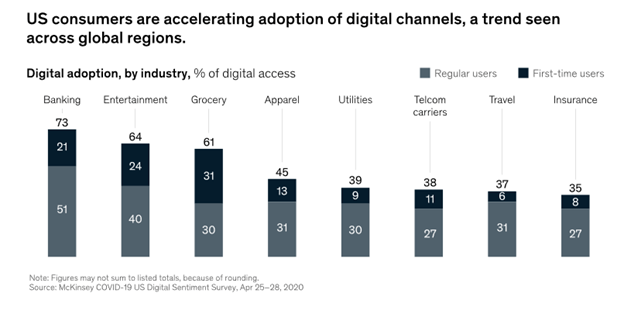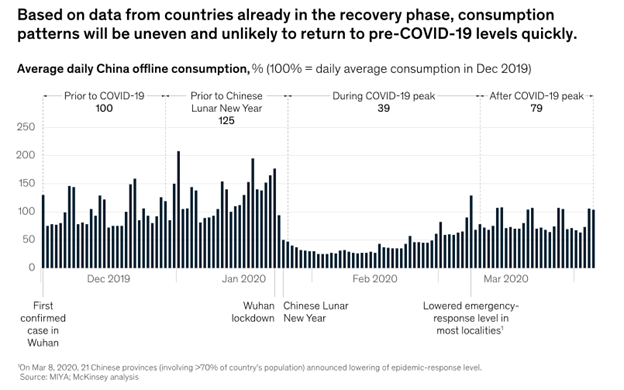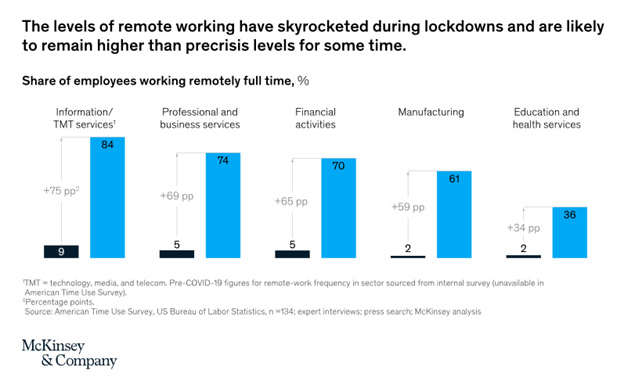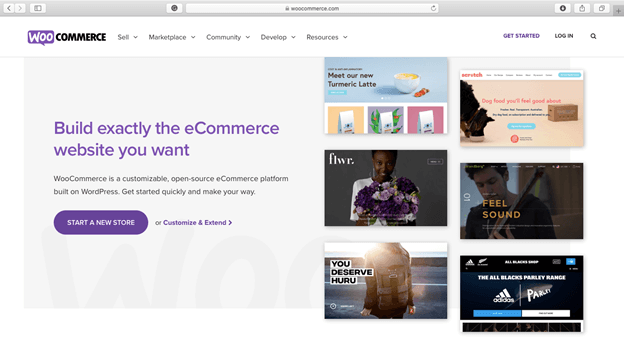It’s 2020, Java has completed 24 years in the industry but is still popular as the most commonly used programming language worldwide. It is supported by a huge community and above 9 M Java programmers in the world.
Java is a not so simple language, yet chosen mostly for custom web application development. Surprisingly, more than 1, 34,861 websites including Amazon, eBay, Dell, and ESPN, have been using Java Frameworks.
The following chart gives you a clear idea about the use of Java in different industries.
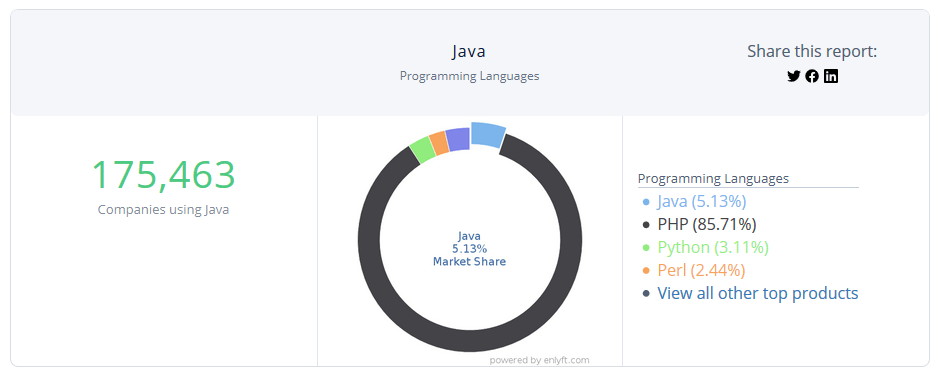
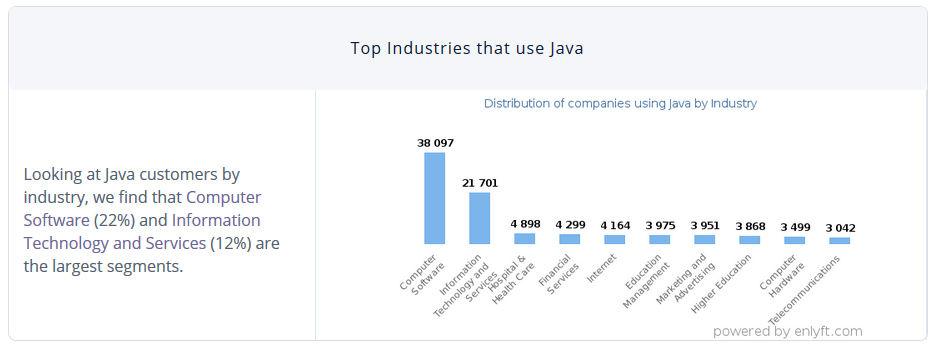 (Source – https://enlyft.com/tech/products/java)
(Source – https://enlyft.com/tech/products/java)
It is now easier to build highly scalable and secure customer-oriented apps with java web frameworks.
Being a strong and dynamic language, when it gets paired with best Java frameworks, offers exceptional solutions for different industry verticals; from eCommerce and finance to banking, education, healthcare, etc.
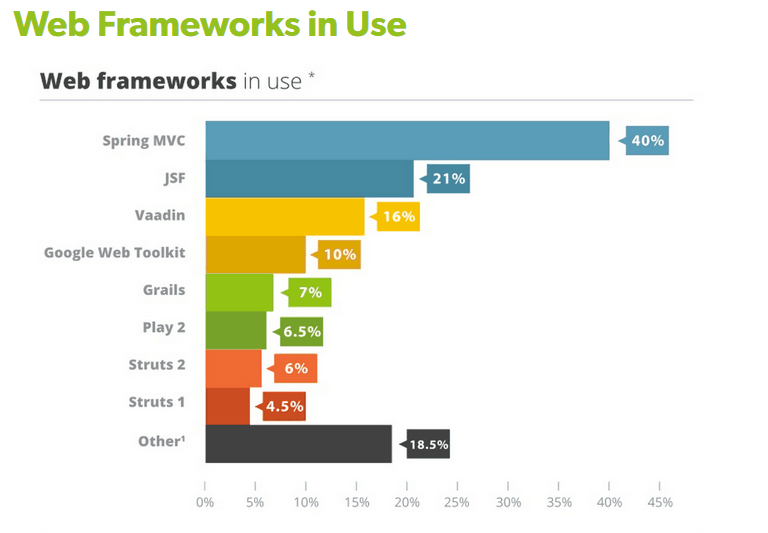
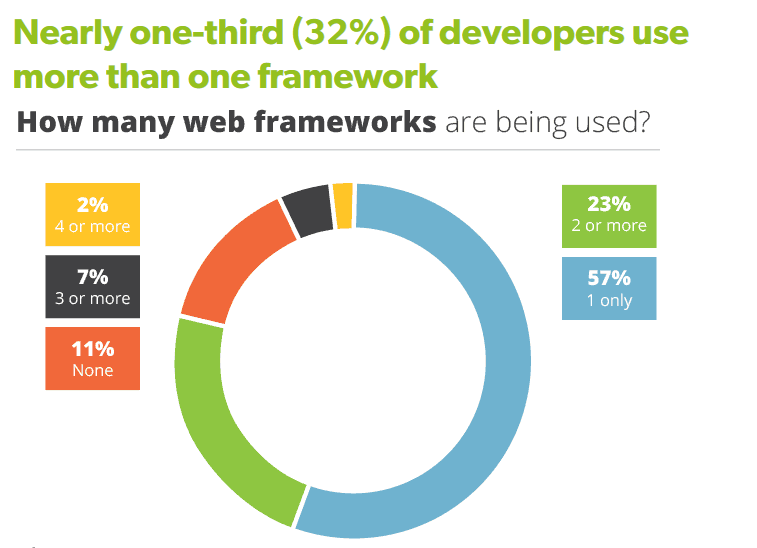 (Source – https://www.jrebel.com/blog/java-web-framework-usage-stats)
(Source – https://www.jrebel.com/blog/java-web-framework-usage-stats)
Java has little competition when programmers need tools to make enterprise-grade applications. It is very helpful in building windows, mobile, web applications, and more.
If you are a web developer with prior experience in Java, you can start with the best Java frameworks anytime. Well, before you take a plunge into it, let’s have a quick review of Java frameworks, their application, and why you always need to choose the best of them.
Never miss an update for us. Join 10,000+ marketers and leaders.
What Java Frameworks Are?
A Java framework is nothing but a per-written code structure available for faster, easier, and effective development/implementation of web applications.
It is a type of template which comes included with specific tools, libraries, compilers, and APIs for increased productivity of the developer.
Java frameworks give developers the flexibility to go for Java web application development by adding their app code and re-using the basic features in it.
They all have the same coding structure and operate with identical terms, concepts, etc.
What is the Use of Java Frameworks for Application Developer?
A Java framework lessens the burden of writing the application code from scratch. It provides a basic structure to the java developers for web apps while automating so many things for reliable and precise outcomes.
They also have predefined classes and functions to respond well to both software systems and hardware devices, based on their type.
As a Java developer, you are free to use any framework just by calling the related inheritance, functions, etc.
Why Choose the Best Java Framework All the Time?
There are so many options available in Java frameworks. However, you can’t expect them all to be perfect in all aspects.
Each of them has its strengths and weaknesses too. By choosing and using the right framework, you can ensure the long term performance of a Java web application.
As a Java developer, you should find a framework that matches your app requirements, not being the best in features.
This is where most developers go wrong. After all, your objective is to develop a web app that functions well and can be extended in the future.
Top Java Frameworks to Work with
You have different frameworks for Java web application development, serving special purposes, and fitting specific app requirements.
Are you still wondering how to choose the right Java framework for your next project?
Here is mentioned a quick list of the best Java web frameworks for your reference.
1. Spring (Modern & Developer Friendly Java framework)
It is a popular, lightweight, and feature-rich web application development framework used for building enterprise-level apps.
The basic features of the spring are effective for making any kind of Java app such as streaming, Web Socket, web, etc. It is better known as a comprehensive modular framework having REST APIs, secured authentication, SOAP services, and many more add-ons.
This framework is excellent for development as well as the implementation of all layers of a real-time app. With it, you can also develop any specific layer of a real-time app which is not possible with other frameworks.
Spring has additional modules including Spring MVC, Spring Boost, Spring Core, Spring Security, Spring ORM, Spring Transaction, etc.
Strengths
- Support classes for the JDBC to ensure decreased errors and improved productivity
- High degree of modularity to add to code readability
- Facilitates XML and annotation-based bean configuration
- Simple dependency injection (DI) to test code data through POJOs (Plain Old Java Objects)
- Provides libraries for backward compatibility and better code testability
- Utility
- Web app development
- Enterprise Java (JEE)
- Any kind of Java app
Examples: – Amazon, eBay, Netflix (Spring Boot)
2. Struts (Fully Featured Enterprise-level Framework)
Struts is an open-source framework based on the MVC model and designed by the ASF (Apache Software Foundation). It is capable of creating a more coupled MVC structure, unlike Spring MVC. Struts enable Java developers to build easy to maintain Java apps all the time.
It is expandable using plugin architecture so that various project needs can be met. Struts integrate well with plugins specific to the JSON, REST, and Config.
You can manage coding tasks that are not exclusively built in the MVC framework by using Struts in integration with other Java frameworks. For instance, the dependence injection included in the spring plugin can be used for object mapping in Struts.
Developers can use various client-side technologies from HTML with Angular to Java Server Pages to create front-end apps.
Strengths:
- Long existence makes Struts reliable and free of errors.
- Compatible with REST, SOAP, and AJAX.
- Allows modular app development, management, and integration with third-party components.
- Supports themes and templates.
- Use of simple POJOs (Plain Old Java Objects)
- Utility:
- The Struts 2 version is perfect for MVC-based web app development.
- It makes use of and expands the Servlet API to let developers adjust to the MVC model.
Examples: – Accenture, Infosys, NexGen Technologies
3. GWT (Free to Use and Open-source Web Framework)
It is one of the best Java frameworks allowing the developers to build front-end Java applications with JavaScript quite fast.
Google Web Toolkit contains core Java API libraries, widgets along with a compiler, and development server. You can develop a Java web app and later cross-compile it into JavaScript with the help of GWT.
You can easily write complex browser-based applications with the use of GWT. It helps in developing and debugging Ajax applications in Java language.
The best thing about Google Web Toolkit is that you don’t need to be proficient in front-end technologies to start with progressive web app development.
It has great functionalities like internationalization, bookmarking, cross-browser compatibility, history management, UI abstractions, etc.
GWT is popular for coding responsive and performance-oriented web apps with relatively less load on server-side and heavy utilization of the client-side.
Strengths
- Supports code reusability for standard web development activities.
- Google APIs can be included in apps built with GWT.
- Ensures support for unit testing, localization, internationalization, etc.
- Online tutorials are available to learn it easily.
- Helps the app load easily by separating code into separate JavaScript files.
Utility
- Helps in developing and maintaining complicated JavaScript front-end apps.
- Inclusion of Google APIs.
- Making of progressive web apps.
Examples: – Blogger, Google AdSense, Google Wallet, etc.
4. Grails (Groovy-based Dynamic Framework)
Grails is a full-stack web app framework, supported by the Groovy JVM (Java Virtual Machine) coding language.
It is a dynamic platform written in an object-oriented language, Groovy, which aims to improve the developer’s productivity.
Java Developers can not only enjoy static-typing but are also capable of static compilation with Grails.
Being a developer, you will always find Java-compatible syntax in it which can be later compiled to JVM bytecode.
Grails integrate well with other popular Java components and technologies such as JEE containers, SiteMesh, spring, Hibernate and Quartz, etc.
Since this framework is built on top of the modular Spring Boot, it inherits the time-saving qualities from the same.
Strengths:
- The Setup procedure is quite easier
- Object-relational mapping (ORM) becomes easy
- Ensures a rapid development cycle
- Integrates with a range of plug-ins for easier coding
- CSS management is easy
- Supports dynamic configuration
- It has clean and clear documentation.
Utility:
- MVC pattern web apps
- Rapid application development
- e-Commerce websites
Examples: – Foodtube, PEP Store, Tropicana, etc.
5. Vaadin (Cross-platform Java Framework)
Vaadin is the last one in the list of top Java frameworks. It is a nice framework focused on UX (User Experience) accessibility.
Vaadin is a robust platform for modernized Java development. You can also use it to build custom component-based web apps.
A big plus of using the Vaadin framework is automated communication between client and server.
Vaadin gives you direct control over the DOM while running on the JVM so that no extra steps will be required to integrate and expand the components.
With the launch of the new version (Vaadin 10), the earlier massive framework has got divided into 2 parts.
Vaadin Flow is the lightweight part among them, handling routing and communication between the client and server.
Vaadin components are easy to integrate with any IDE you choose and use. Due to its cross-platform compatibility, it does not involve any code migration into a separate platform.
Utility:
- Modernized Java app development
- Custom component-based web development
Strengths
- Facilitates data binding with MVP or MVC
- Dragging and dropping support, together with other, wonderful features that lead to easy development of single-page User Interfaces for Java apps.
- Web Socket support for automated server-browser communication.
- Routing with the different levels of the nested route and multiple parameter support
- Supports Java Virtual Machine languages such as Scala and Kotlin.
- Built-in Spring support
Examples: – Puma, Volkswagen, Bank of America, etc.
I’ve worked with the team at AndolaSoft on multiple websites. They are professional, responsive, & easy to work with. I’ve had great experiences & would recommend their services to anyone.
Ruthie Miller, Sr. Mktg. Specialist
Salesforce, Houston, Texas
LEARN MORE
Conclusion
The above list is not final as you have many other popular Java frameworks beyond it to cover your project needs.
All the above-mentioned ones are great—as far as popularity and use are concerned. Just remember that once you use a framework and learn to make the most of its features, changing to another one will never be difficult.
Before picking a framework, weigh your app requirements, its level, and your work experience with Web Frameworks and in Java application programming. Then, tick on the framework that fits your needs.
We are here to recommend the most suitable Java framework for your web application development.
Share your app requirements and see how fast we can offer you a solution.
For Java related queries or concerns, chat with us now!









